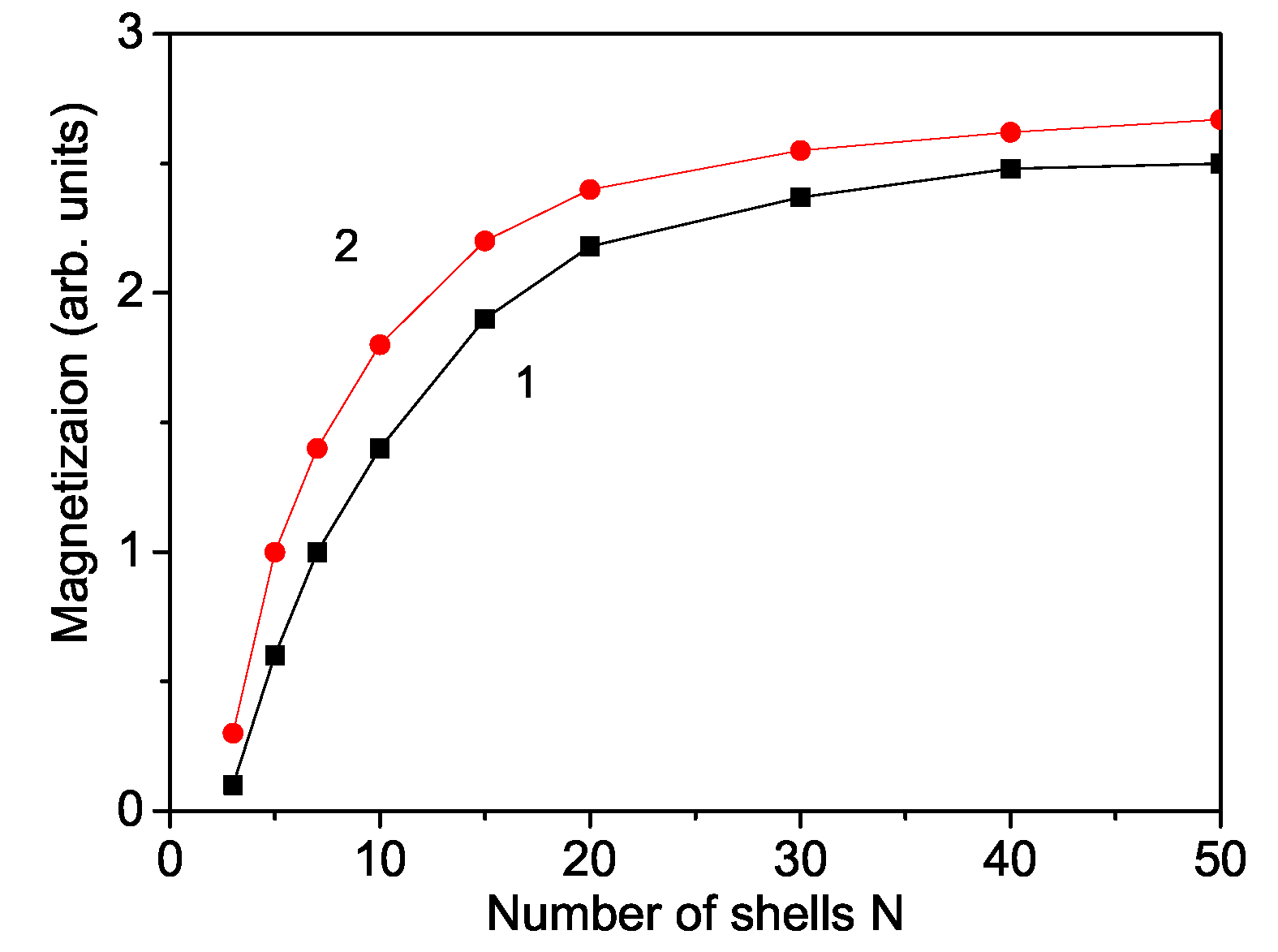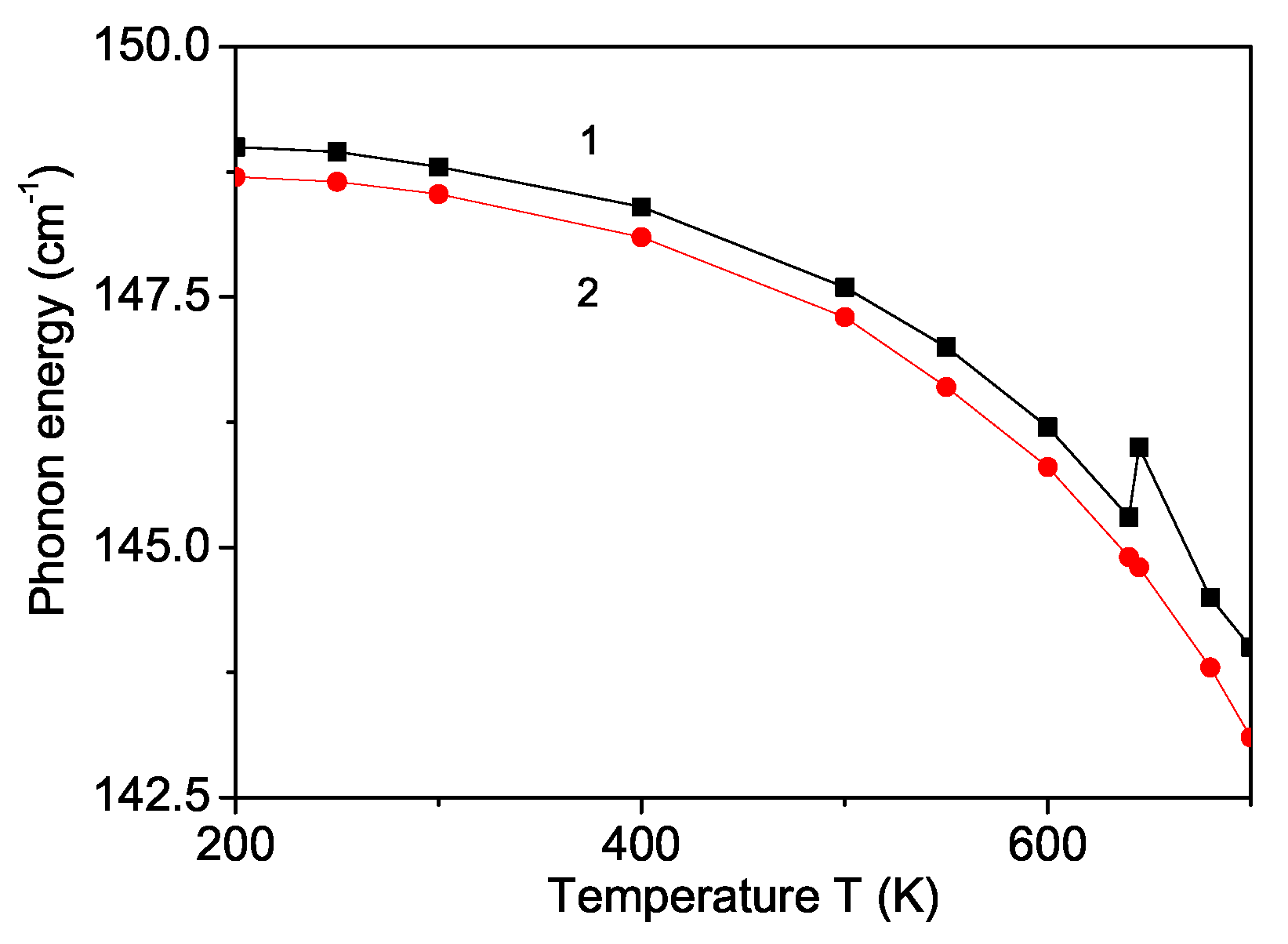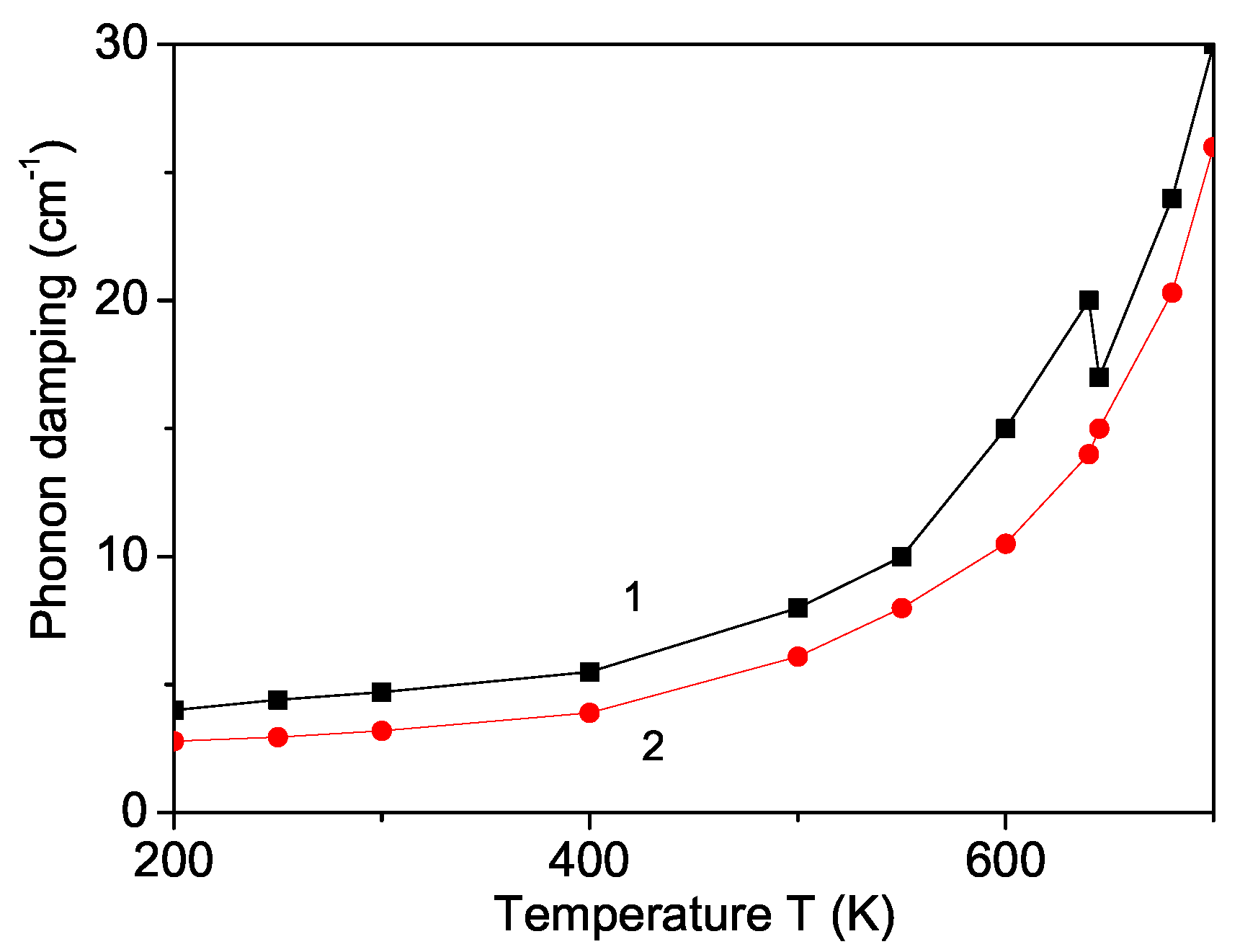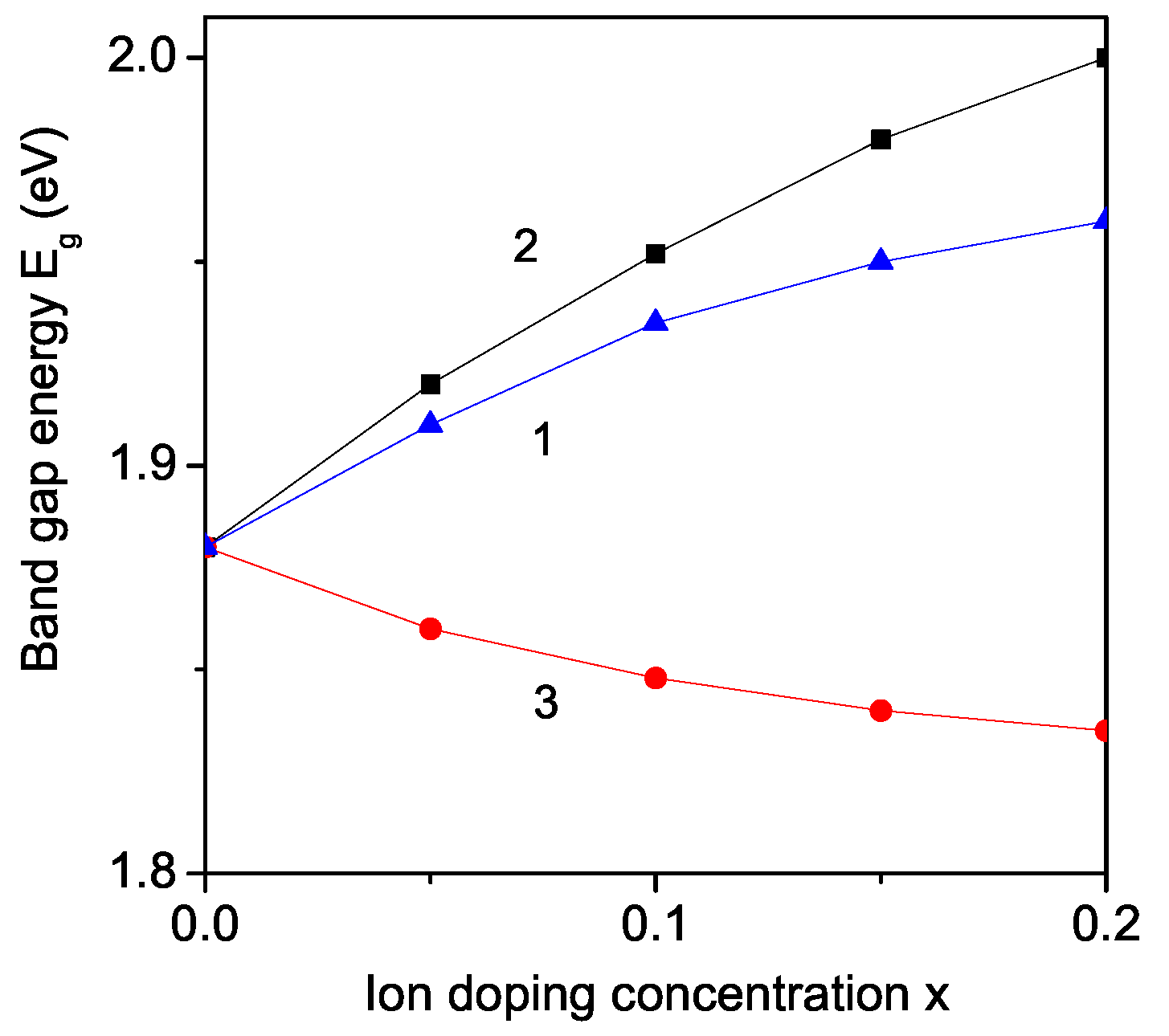Multiferroic, Phonon and Optical Properties of Pure and Ion-Doped YFeO3 Nanoparticles
Abstract
1. Introduction
2. Model and Methods
3. Results and Discussion
3.1. Size and Shape Dependence of the Magnetization
3.2. Electric Field Dependence of the Polarization
3.3. Ion Doping Effects on the Magnetization
3.3.1. Co Substitution at the Fe Site
3.3.2. Er Substitution at the Y Site
3.3.3. Ca Substitution at the Y Site
3.3.4. Ti Substitution at the Fe Site
3.3.5. Mn Substitution at the Fe Site
3.4. Ion Doping Effects on the Polarization
3.5. Temperature and Magnetic Field Dependence of the Phonon Energy
3.6. Gd and Sm Doping Dependence of the Phonon Energy
3.7. Temperature and Magnetic Field Dependence of the Phonon Damping
3.8. Ion Doping Effects on the Band Gap Energy
3.8.1. Ti Ion Doping at the Fe Site
3.8.2. Sm Ion Doping at the Y Site
3.8.3. Co Ion Doping at the Fe Site
4. Conclusions
Author Contributions
Funding
Data Availability Statement
Conflicts of Interest
References
- Lima, E.; Martins, T.B.; Rechenberg, H.R.; Goya, G.F.; Cavelius, C.; Rapalaviciute, R.; Hao, S.; Mathur, S. Numerical simulation of magnetic interactions in polycrystalline YFeO3. J. Magn. Magn. Mater. 2008, 320, 622–629. [Google Scholar] [CrossRef][Green Version]
- Shang, M.; Zhang, C.; Zhang, T.; Yuan, L.; Ge, L.; Yuan, H.; Feng, S. The multiferroic perovskite YFeO3. Appl. Phys. Lett. 2013, 102, 062903. [Google Scholar] [CrossRef]
- Jacob, K.T.; Rajitha, G.J. Nonstoichiometry, Defects and Thermodynamic Properties of YFeO3, YFe2O4 and Y3Fe5O12. Solid State Ionics 2012, 224, 32. [Google Scholar] [CrossRef]
- Hui, S.; Xu, J.; Wu, A. Preparation and characterization of perovskite REFeO3 nanocrystalline powders. J. Rare Earths 2010, 28, 416. [Google Scholar]
- Ahmad, T.; Lone, I.H.; Ansari, S.G.; Ahmed, J.; Ahamad, T.; Alshehri, S.M. Multifunctional properties and applications of yttrium ferrite nanoparticles prepared by citrate precursor route. Mater. Des. 2017, 126, 331. [Google Scholar] [CrossRef]
- Lone, I.H.; Ahmed, J.; Ahmad, T. Reverse Micellar Synthesis, Characterization, Magnetic and Ferroelectric Properties of YFeO3 Nanoparticles. Mater. Today Proc. 2018, 5, 15303–15310. [Google Scholar] [CrossRef]
- Nagrare, B.S.; Kekade, S.S.; Thombare, B.; Reddy, R.V.; Patil, S.I. Hyperfine interaction, Raman and magnetic study of YFeO3 nanocrystals. Solid State Commun. 2018, 280, 32. [Google Scholar] [CrossRef]
- Raut, S.; Babu, P.D.; Sharma, R.K.; Pattanayak, R.; Panigrahi, S. Grain boundary-dominated electrical conduction and anomalous optical-phonon behaviour near the Neel temperature in YFeO3 ceramics. J. Appl. Phys. 2018, 123, 174101. [Google Scholar] [CrossRef]
- Saha, J.; Jana, Y.M.; Mukherjee, G.D.; Mondal, R.; Kumar, S.; Gupta, H.C. Structure, Moessbauer spectroscopy and vibration phonon spectra in valence-bond force-field model approach for distorted perovskites AFeO3 (A = La, Y). Mater. Chem. Phys. 2020, 240, 122286. [Google Scholar] [CrossRef]
- Coutinho, P.V.; Cunha, F.; Barrozo, P. Structural, vibrational and magnetic properties of the orthoferrites LaFeO3 and YFeO3: A comparative study. Solid State Commun. 2017, 252, 59–63. [Google Scholar] [CrossRef]
- Cheng, M.; Jiang, G.; Yang, W.; Duan, L.; Peng, W.; Chen, J.; Wang, X. Study of Y1-xErxFeO3 (0 ≤ x ≤ 1) powder synthesized by sol-gel method and their magnetic properties. J. Magn. Magn. Mater. 2016, 417, 87. [Google Scholar] [CrossRef]
- Tien, N.A.; Diem, C.H.; Linh, N.T.T.; Mittova, V.O.; Huong, D.T.; Mittova, I.Y. Structural and magnetic properties of YFe1-xCoxO3 (0.1 ≤ x ≤ 0.5) perovskite nanomaterials synthesized by coprecipitation method. Nanosyst. Phys. Chem. Math. 2018, 9, 424–429. [Google Scholar]
- Yuan, X.; Tang, Y.; Sun, Y.; Xu, M. Structure and magnetic properties of Y1-xLuxFeO3 (0 ≤ x ≤ 1) ceramics. J. Appl. Phys. 2012, 111, 053911. [Google Scholar] [CrossRef]
- Khalifa, N.O.; Widatallah, H.M.; Gismelseed, A.M.; Al-Mabsali, F.N.; Sofin, R.G.S.; M. Pekala, M. Magnetic and Moessbauer studies of pure and Ti-doped YFeO3 nanocrystalline particles prepared by mechanical milling and subsequent sintering. Hyperfine Interact. 2016, 237, 46. [Google Scholar] [CrossRef]
- Solorzano, M.; Duran, A.; Lopez, R.; Mata, J.; Falconi, R. Magnetic and Moessbauer studies of pure and Ti-doped YFeO3 nanocrystalline particles prepared by mechanical milling and subsequent sintering. J. Mater. Sci. Mater. Electr. 2020, 31, 14478–14486. [Google Scholar]
- Madolappa, S.; Ponraj, B.; Bhimireddi, R.; Varma, K.B.R. Enhanced magnetic and dielectric properties of Ti-doped YFeO3 ceramics. J. Am. Ceram. Soc. 2017, 100, 2641. [Google Scholar] [CrossRef]
- Rosales-Gonzalez, O.; Jesus, F.S.-D.; Pedro-Garcia, F.; Cortes-Escobedo, C.A.; Ramirez-Cardona, M.; Bolarin-Miro, A.M. Enhanced Multiferroic Properties of YFeO3 by Doping with Bi3+. Materials 2019, 12, 2054. [Google Scholar] [CrossRef]
- Yuan, X.; Sun, Y.; Xu, M. Effect of Gd substitution on the structure and magnetic properties of YFeO3 ceramics. J. Solid State Chem. 2012, 196, 362. [Google Scholar] [CrossRef]
- Sundarayya, Y.; Mandal, P.; Sundaresan, A.; Rao, C.N.R. Moessbauer spectroscopic study of spin reorientation in Mn-substituted yttrium orthoferrite. J. Phys. Condens. Matter 2011, 23, 436001. [Google Scholar] [CrossRef]
- Berezhnaya, M.V.; Mittova, I.Y.; Perov, N.S.; Almyasheva, O.V.; Nguyen, A.T.; Mittova, V.O.; Bessalova, V.V.; Viryutina, E.L. Production of Zinc-Doped Yttrium Ferrite Nanopowders by the Sol-Gel Method. Russ. J. Inorg. Chem. 2018, 63, 742. [Google Scholar] [CrossRef]
- Bharadwaj, P.S.J.; Kundu, S.; Kollipara, V.S.; Varma, K.B.R. Structural, optical and magnetic properties of Sm3+ doped yttrium orthoferrite (YFeO3) obtained by sol-gel synthesis route. J. Phys. Condens. Matter 2020, 32, 035810. [Google Scholar] [CrossRef]
- Dasari, N.; Mandal, P.; Sundaresan, A.; Vidhyadhiraja, N.S. Weak ferromagnetism and magnetization reversal in YFe1-xCrxO3. Europhys. Lett. 2012, 99, 17008. [Google Scholar] [CrossRef]
- Ji, L.; Jiang, G.; Wu, D.; Chen, J. Study on the influence of ion doping on the crystal structure and magnetic properties of YFeO3. Mater. Res. Express 2020, 7, 066103. [Google Scholar] [CrossRef]
- Wang, M.; Wang, T. Structural, Magnetic and Optical Properties of Gd and Co Co-Doped YFeO3 Nanopowders. Materials 2019, 12, 2423. [Google Scholar] [CrossRef]
- Wang, M.; Zhao, S.; Zhang, X.; Huang, C.; Zhu, Y. Effect of La addition on structural, magnetic and optical properties of multiferroic YFeO3 nanopowders fabricated by low-temperature solid-state reaction method. In Proceedings of the 6th International Conference on Mechanical Engineering and Automation Science (ICMEAS), Moscow, Russia, 29–31 October 2020; Volume 1, pp. 242–246. [Google Scholar]
- Wang, M.; Cheng, L.; Huang, L.; Pan, S.; Yao, Q.; Hu, C.; Liang, Q.; Zhou, H. Effect of Sr doped the YFeO3 rare earth ortho-ferrite on structure, magnetic properties, and microwave absorption performance. Ceram. Intern. 2021, in press. [Google Scholar]
- Treves, D. Studies on Orthoferrites at the Weizmann Institute of Science. J. Appl. Phys. 1965, 36, 1033. [Google Scholar] [CrossRef]
- Park, K.; Sim, H.; Leiner, J.C.; Yoshida, Y.; Jeong, J.; Yano, S.; Gardner, J.; Bourges, P.; Klicpera, M.; Sechovsky, V.; et al. Low-energy spin dynamics of orthoferrites AFeO3 (A = Y, La, Bi). J. Phys. Condens. Matter 2018, 30, 235802. [Google Scholar] [CrossRef] [PubMed]
- Stoeffler, D.; Chaker, Z. First principles study of the electronic structure and magnetic properties of YFeO3 oxide. J. Magn. Magn. Mater. 2017, 442, 255–264. [Google Scholar] [CrossRef]
- Martinez-Aguilar, E.; Hmok, H.L.; Ribas-Arino, J.; Beltrones, J.M.S.; Lozada-Morales, R. Structural, ferroelectric, and optical properties of Bi3+ doped YFeO3: A first-principles study. Int. J. Quantum Chem. 2021, 121, e26551. [Google Scholar] [CrossRef]
- Tserkovnikov, Y.A. Decoupling of chains of Green’s functions. Teor. Mat. Fiz. 1971, 7, 250. [Google Scholar] [CrossRef]
- Blinc, R.; Zeks, B. Soft Modes in Ferroelectrics and Antiferroelectrics; North-Holland: Amsterdam, The Netherlands, 1974. [Google Scholar]
- Pirc, R.; Blinc, R. Off-center Ti model of barium titanate. Phys. Rev. B 2004, 70, 134107. [Google Scholar] [CrossRef]
- Bergum, K.; Okamoto, H.; Fjellvag, H.; Grande, T.; Einarsruda, M.-A.; Selbach, S.M. Synthesis, structure and magnetic properties of nanocrystalline YMnO3. Dalton Trans. 2011, 40, 7583. [Google Scholar] [CrossRef] [PubMed]
- Chen, P.; Grisolia, M.N.; Zhao, H.J.; Gonzalez-Vazquez, O.E.; Bellaiche, L.; Bibes, M.; Liu, B.-G.; Iniguez, J. Energetics of oxygen-octahedra rotations in perovskite oxides from first principles. Phys. Rev. B 2018, 97, 024113. [Google Scholar] [CrossRef]
- Wesselinowa, J.M.; Apostolov, A.T. Self-consistent theory of spin-phonon interactions in ferromagnetic semiconductors. J. Phys. Condens. Matter 1993, 5, 3555. [Google Scholar] [CrossRef]
- Michael, T.; Trimper, S.; Wesselinowa, J.M. Size effects on static and dynamic properties of ferroelectric nanoparticles. Phys. Rev. B 2007, 76, 094107. [Google Scholar] [CrossRef]
- Shang, M.; Liu, H.; Zhang, L.; Sun, F.; Yuan, H.; Zhao, C. Multiferroicity in the YFeO3 crystal. Funct. Mater. Lett. 2020, 13, 1950088. [Google Scholar] [CrossRef]
- Wesselniowa, J.M. Size and anisotropy effects on magnetic properties of antiferromagnetic nanoparticles. J. Magn. Magn. Mater. 2010, 322, 234. [Google Scholar] [CrossRef]
- Sui, Y.; Lu, F.; Liu, X.; Zhang, Y.; Sun, X.; Liu, C. A novel hexagonal YFeO3 3D nanomaterial with room temperature ferromagnetic properties prepared by self-assembling method. Results Mater. 2021, 10, 100186. [Google Scholar] [CrossRef]
- Popkov, V.I.; Almjasheva, O.V.; Semenova, A.S.; Kellerman, D.G.; Nevedomskiy, V.N.; Gusarov, V.V. Magnetic properties of YFeO3 nanocrystals obtained by different soft-chemical methods. J. Mater. Sci. Mater. Electron. 2017, 28, 7163–7170. [Google Scholar] [CrossRef]
- Yuan, L.; Huang, K.; Wang, S.; Hou, C.; Wu, X.; Zou, B.; Feng, S. Crystal Shape Tailoring in Perovskite Structure Rare-Earth Ferrites REFeO3 (RE = La, Pr, Sm, Dy, Er, and Y) and Shape-Dependent Magnetic Properties of YFeO3. Cryst. Growth Des. 2016, 16, 6522. [Google Scholar] [CrossRef]
- Arlt, G.; Hennings, D.; With, G.D. Dielectric properties of fine-grained barium titanate ceramics. J. Appl. Phys. 1985, 58, 1619. [Google Scholar] [CrossRef]
- Nguyen, T.A.; Pham, V.; Chau, D.H.; Mittova, V.O.; Mittova, I.Y.; Kopeychenko, E.I.; Nguyen, L.T.T.; Bui, V.X.; Nguyen, A.T.P. Effect of Ni substitution on phase transition, crystal structure and magnetic properties of nanostructured YFeO3 perovskite. J. Mol. Struct. 2020, 1215, 128293. [Google Scholar] [CrossRef]
- Tien, N.A.; Mittova, I.Y.; Solodukhin, D.O.; Almyasheva, O.V.; Mittova, V.O.; Demidov, S.Y. Sol-Gel Formation and Properties of Nanocrystals of Solid Solutions Y1-xCaxFeO3. Russ. J. Inorg. Chem. 2014, 59, 40. [Google Scholar]
- Deka, B.; Ravi, S.; Perumal, A.; Pamu, D. Effect of Mn doping on magnetic and dielectric properties of YFeO3. Ceram. Int. 2017, 43, 1323–1334. [Google Scholar] [CrossRef]
- Deka, B.; Ravi, S.; Perumal, A. Study of Exchange Bias in Mn-Doped YFeO3 Compound. J. Supercond. Nov. Magn. 2016, 29, 2165–2170. [Google Scholar] [CrossRef]








Publisher’s Note: MDPI stays neutral with regard to jurisdictional claims in published maps and institutional affiliations. |
© 2021 by the authors. Licensee MDPI, Basel, Switzerland. This article is an open access article distributed under the terms and conditions of the Creative Commons Attribution (CC BY) license (https://creativecommons.org/licenses/by/4.0/).
Share and Cite
Apostolov, A.; Apostolova, I.; Wesselinowa, J. Multiferroic, Phonon and Optical Properties of Pure and Ion-Doped YFeO3 Nanoparticles. Nanomaterials 2021, 11, 2731. https://doi.org/10.3390/nano11102731
Apostolov A, Apostolova I, Wesselinowa J. Multiferroic, Phonon and Optical Properties of Pure and Ion-Doped YFeO3 Nanoparticles. Nanomaterials. 2021; 11(10):2731. https://doi.org/10.3390/nano11102731
Chicago/Turabian StyleApostolov, Angel, Iliana Apostolova, and Julia Wesselinowa. 2021. "Multiferroic, Phonon and Optical Properties of Pure and Ion-Doped YFeO3 Nanoparticles" Nanomaterials 11, no. 10: 2731. https://doi.org/10.3390/nano11102731
APA StyleApostolov, A., Apostolova, I., & Wesselinowa, J. (2021). Multiferroic, Phonon and Optical Properties of Pure and Ion-Doped YFeO3 Nanoparticles. Nanomaterials, 11(10), 2731. https://doi.org/10.3390/nano11102731




